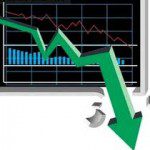Almost all of the major financial crashes in U.S. history are very closely tied to a seven year pattern  that we find in the Bible known as “the Shemitah”. In this article I am going to attempt to explain what the Shemitah is, and what this Biblical pattern seems to indicate may happen in 2015. If you are an atheist, an agnostic, or are generally skeptical by nature, this article might prove quite challenging for you. I would ask that you withhold judgment until you have examined the evidence. When I first heard about these things, I had to go verify the facts for myself, because they are truly extraordinary.
that we find in the Bible known as “the Shemitah”. In this article I am going to attempt to explain what the Shemitah is, and what this Biblical pattern seems to indicate may happen in 2015. If you are an atheist, an agnostic, or are generally skeptical by nature, this article might prove quite challenging for you. I would ask that you withhold judgment until you have examined the evidence. When I first heard about these things, I had to go verify the facts for myself, because they are truly extraordinary.
By Michael Snyder (theeconomiccollapseblog.com). The article* was originally published under the title The Shemitah: The Biblical Pattern Which Indicates That A Financial Collapse May Be Coming In 2015.
What is “the Shemitah”?
In the Bible, the people of Israel were commanded to let the land lie fallow every seven years. There would be no sowing and no reaping, and this is something that God took very seriously. In fact, the failure to observe these Sabbath years was one of the main reasons cited in the Scriptures for why the Jewish people were exiled to Babylon in 586 BC.
There was more to the Shemitah year than just letting the land lie fallow; on the last day of the Shemitah year, the people of Israel were instructed to perform a releasing of debts. We find the following in Deuteronomy chapter 15; “At the end of every seven years you shall grant a relinquishing of debts. This is the manner of the relinquishing: Every creditor that has loaned anything to his neighbor shall relinquish it. He shall not exact it of his neighbor, or of his brother, because it is called the Lord’s relinquishment.” This happened at the end of every seven years on Elul 29 – the day right before Rosh Hashanah on the Biblical calendar.
What is the Relevance of the Shemitah Today?
- On September 17th, 2001 (which was Elul 29 on the Jewish calendar), we witnessed the greatest one day stock market crash in U.S. history up to that time. The Dow fell an astounding 684 points, and it was a record that held for precisely seven years until the end of the next Shemitah year.
- On September 29th, 2008 the Dow plummeted 777 points, which still today remains the greatest one day stock market crash of all time. It turns out that September 29th, 2008 corresponded with Elul 29 on the Jewish calendar – the precise day when the Bible calls for a releasing of debts.
On the very last day of the last two Shemitah years, the stock market crashed so badly that it set a brand new all-time record and now we are in another Shemitah year. It began last fall, and it will end next September. Could it be possible that we will see another historic market crash?
True, we should never put God in a box – just because something has happened in the past does not mean that it will happen again – but we should not rule anything out either. According to Jonathan Cahn, in his new book “The Mystery of the Shemitah: The 3,000-Year-Old Mystery That Holds the Secret of America’s Future, the World’s Future, and Your Future!”, if we are going to see something happen, it will probably occur as the Shemitah year comes to an end,… not at the beginning…and the last day of the year, Elul 29 on the Hebrew calendar, will occur on Sept. 13, 2015…
It is also very interesting to note that there will also be a solar eclipse on September 13th, 2015. Over the past century, there have only been two other times when a solar eclipse has corresponded with the end of a Shemitah year – 1931 and 1987 – and…those solar eclipses foreshadowed major financial disasters.
- In 1931, a solar eclipse took place on Sept. 12 – the end of a “Shemitah” year. Eight days later, England abandoned the gold standard, setting off market crashes and bank failures around the world. It also ushered in the greatest month-long stock market percentage crash in Wall Street history.
- In 1987, a solar eclipse took place Sept. 23 – again the end of a “Shemitah” year. Less than 30 days later came “Black Monday” the greatest percentage crash in Wall Street history.
Conclusion
Is Cahn predicting doom and gloom on Sept. 13, 2015? He’s careful to avoid a prediction, saying, “In the past, this ushered in the worst collapses in Wall Street history. What will it bring this time? Again, as before, the phenomenon does not have to manifest at the next convergence but, at the same time, and again, it is wise to take note.”
What is going to happen this time? We will just have to wait and see but, without a doubt, so many of the same patterns that we witnessed just prior to the financial crash of 2008 are happening again right before our very eyes.
It has been said that those that do not learn from history are doomed to repeat it. Perhaps you believe that there is something to “the Shemitah”, or perhaps you think that it is all a bunch of nonsense, but at least now you know what everyone is talking about. What you choose to do with this information is up to you.
[The above article is presented by Lorimer Wilson, editor of www.munKNEE.com and the FREE Market Intelligence Report newsletter (sample here) and may have been edited ([ ]), abridged (…) and/or reformatted (some sub-titles and bold/italics emphases) for the sake of clarity and brevity to ensure a fast and easy read. The author’s views and conclusions are unaltered and no personal comments have been included to maintain the integrity of the original article. This paragraph must be included in any article re-posting to avoid copyright infringement.]
*Original Source: http://theeconomiccollapseblog.com/archives/shemitah-biblical-pattern-indicates-financial-collapse-may-coming-2015
Related Articles:
1. September To Bring Stock Market Crash & Beginning Of Economic Depression
We are now on HIGH ALERT!!!!! Grand Supercycle degree wave (IV)’s decline could start soon. We need to pay close attention and be prepared for a September 2015 event that triggers a stock market crash and economic depression.
2. The Stock Market Crash Season Is Here & Here’s What the Future Holds
Where do we go from here? I can promise you, it’s only going to get worse! Like our economy, there is clear seasonality when it comes to stocks. Trends flesh out overtime. It’s not random. From that data, I want to give you a picture of what the next few months might look like.
3. Reversion to the Mean of the S&P 500 Means A Further 33% Decline
Historically, the average P/E ratio of the S&P 500 is 16.64, and a reversion to said mean would represent a further decline in the index of 33%.
4. S&P 500 Likely To Decline A Further 10-30% Over The Next Year – Here’s Why
Over the last week, the S&P 500 has been decimated…and decades of financial data suggest that further downside is entirely likely…anywhere from 10-30% is over the next year. Here’s why.
5. Go With the Flow! Time the Market By Using These 6 Momentum Indicators
Yes, you can time the market! Assessing the relative levels of greed and fear in the market at any given point in time is an effective way of doing so and this article outlines the 6 most popular momentum indicators and explains how, why and where they should be used.
6. You CAN Time the Market If You Know How! Here’s How
Much has been written that it is impossible to time the market – that a buy and hold approach is much more rewarding – but that is simply not the case. This article provides you with the knowledge and a great charting service (free) to do just that. All you need do then is set aside the time and make the effort to apply the disciplines learned.
7. Time the Market With These Market Strength & Volatility Indicators
There are many indicators available that provide information on stock and index movement to help you time the market and make money. Market strength and volatility are two such categories of indicators and a description of six of them are described in this “cut and save” article. Read on! Words: 974
8. Market Timing Works Using These Trend Indicators
The trend is your friend and this article reviews the 7 most popular trend indicators to help you make an extensive and in-depth assessment of whether you should be buying or selling.
9. Trying to Time the Market Is a Fool’s Errand – Here’s Proof
Pullbacks happen, and usually the market recovers, so trying to time the market is probably a fool’s errand – and a money loser.
10. Predicting What the Stock Market Will Do Is Impossible – Here’s More Proof
Predicting what the stock market will do in the next 12 months is tantamount to predicting coin flips. Here’s more proof that past stock market performance tells you nothing about future results — literally nothing.
 munKNEE.com Your Key to Making Money
munKNEE.com Your Key to Making Money


